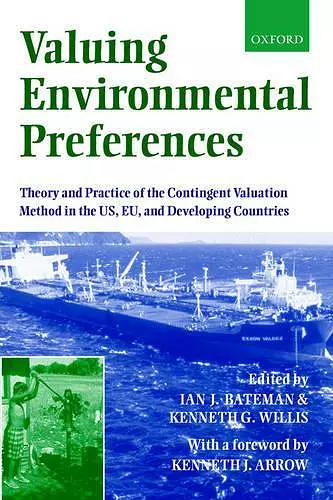Valuing Environmental Preferences
Theory and Practice of the Contingent Valuation Method in the US, EU , and developing Countries
Ian J Bateman editor Kenneth G Willis editor
Format:Paperback
Publisher:Oxford University Press
Published:1st Nov '01
Currently unavailable, and unfortunately no date known when it will be back

Just as individuals have preferences regarding the various goods and services they purchase every day, so they also hold preferences regrding public goods such as hose provided by the naural environment. However, unlike provate goods, environmental goods often cannot be valued by direct reference o any market price. Thsi amkes economic analysis of the costs and benefits of environmental change problematic. Over the past few decades a number of methods have developed to address this problem by attempting to value environmental preferences. Principal among hese has been the contingent valuation (CV) method which uses surveys to ask individuals how much they would be willing to pay or willing to accept in compensation for gains and losses of environmental goods. The period from the mid-1980s to the present day has seen a m,assive expansion in use of the CV method. From its originalroots int eh USA, through Europe and the developed world, the method has now reached worldwide application with a substantial proportion of current studies being undertaken in developing countries where environmental services are often the dominating determinant of everyday living standards. The method has simultaneously moved from the realm of pure academic speculation into the sphere of instiutional decision analysis. However, the past decade also witness a developing critique of the CV method with a number of commentators questioning the underlying validity of its dervied valuations. This volume, therefore, reflects a time of heated debate, as wellas from commentators who see it as an interesting experimental tool regardless of the question of absolute validity of estimates. The book embraces the theoritical, methodologicl, empirical, and institutional aspects of the current debate. It covers US, European , and developing country applications, and the institutional frameworks within which CV studies are applied.
This is a book that should be on the shelves of anyone with an interest in environmental valuation and of CV in particular. Whilst it is not a CV handbook on 'best practice', it is an invaluable source of reference on a whole range of issues concerning the use of the CV method. * Journal of Environmental Planning and Management *
The case studies are particularly informative and well balanced. This book is extremely attractively priced and should find a place on the shelves of many libraries and individuals who have an interest/concern in their attempts to evaluate the many and growing environmental problems facing our planet in the 21st century. * International Journal of Environmental Studies23/01/2003 *
Very interesting multi-author truly international book ... very well referenced ... good index. * International Journal of Environmental Studies *
ISBN: 9780199248919
Dimensions: 234mm x 155mm x 36mm
Weight: 958g
668 pages